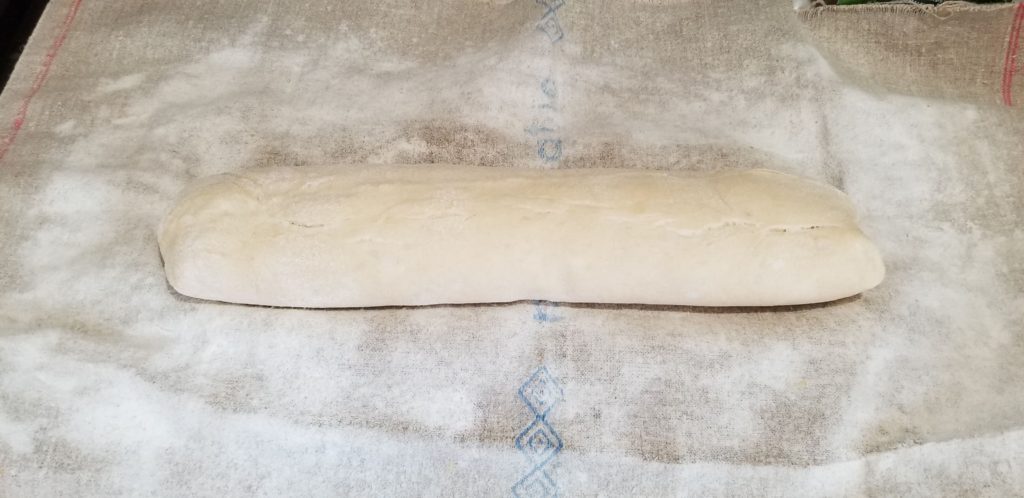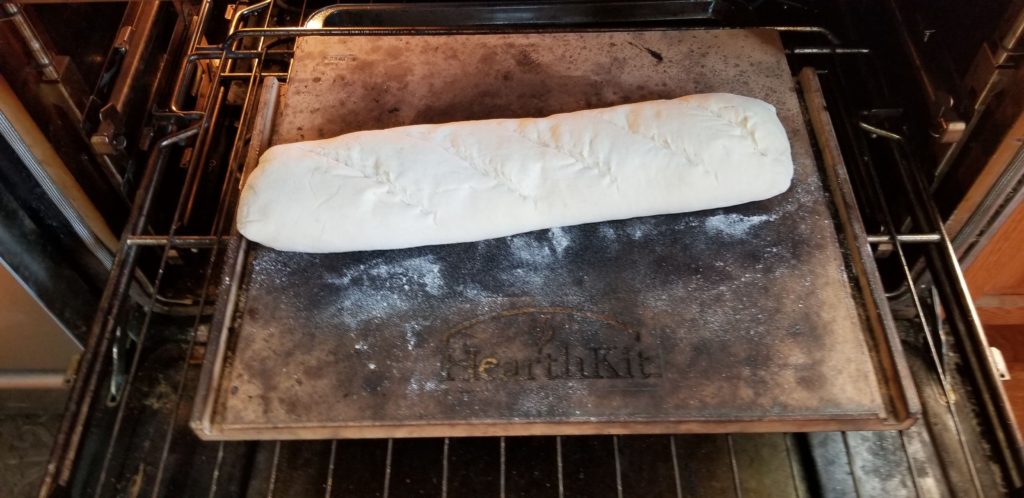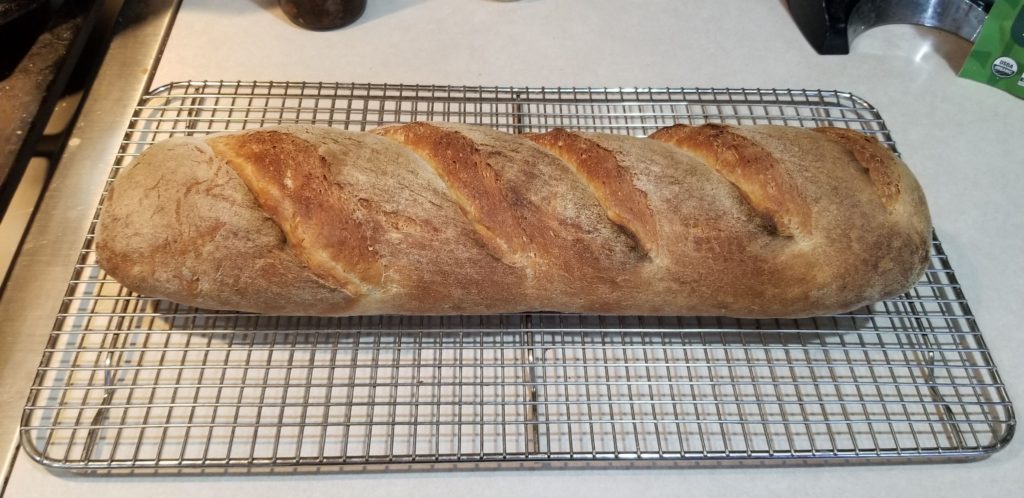The House Bread
This is a nice crusty loaf I used to make a couple times a week. Sadly, I cannot eat wheat – it gets me quite sick – so I don’t as often as my family would like, but I do from time to time to make them happy. Since it involves a poolish, you need to have the presence of mind to start it the night before. It sounds like a lot of work cuz the number of steps, but the actual time on task is minimal.
The Night Before
Make a poolish: sift 1½ cups all-purpose flour (I like King Arthur’s) into a smallish bowl. Sprinkle a pinch (¼-½ teaspoon or so) yeast atop it, and whisk to combine. Pour in 1½ cups water. Whisk thoroughly. Cover with a dinner plate and leave some place room temperature, more or less.

The Next Morning
Your poolish should be nice and bubbly. If all is well, take a medium-sized bowl and sift therein 2 cups all-purpose flour, which you will combine well with 1½ teaspoon salt and 2 teaspoons diastatic malt powder (another goody you can find at King Arthur). Atop this, pour in your poolish, mix with a spoon until all comes together, then STOP and let rest and autolyse approx 15 minutes
Knead, adding a little more all-purpose flour if it’s still a bit sticky (just don’t overdo it with the flour). I use a turn-push-fold sort of motion, with my right hand doing all the work. (I also do this right in the bowl I mixed it in, instead of on a bench.)
Once your dough is sufficiently kneaded, give it a roll around to make it generally smooth and spherical, and plop it in a clean, lightly oiled (cooking spray is fine) bowl (or in my case, a deli pan), roll it around to apply a coat of said oil to the ball (or hit it with another spritz of spray), and cover with a sheet of cellophane. Park this assemblage somewhere room-temperatureish.

Late Morning
A couple hours later, your ball should have doubled in bulk. On your counter or table have handy a well-floured baker’s couche (a well-floured CLEAN side towel would probably do in a pinch). Fold the dough over once or twice in your hands to distribute the yeast and deflate a bit, then shape into a rectangular blob on the center of the couche/towel, wrap lengthwise, and fold up the flaps at the end. You can do it however you like, but I handle mine minimally, and, as I move it from the deli pan onto the couche, give it a bit of a stretch so that I have something vaguely baguette shaped. Since it’s been folded, there’s a seam down the middle, which I pinch closed best I can (it’ll be held together by the rolled-up couche, don’t forget, and flipped directly from it onto the stone in the oven so the seam will be down, anyway). Should I do a proper roll-and-form? Probably, but I’m too lazy—you can if you want a more polished product.

If you have a baking (or pizza) stone, now’s probably a good time to get it into the oven. If yours is of sufficiently strong constitution (caution: not all are), you can place on a rack beneath it a pan into which you will add water when the loaf enters the hot oven. This will create copious steam (hence the warning—I’ve had a cheap stone shatter on me). We have an old metal casserole pan that lives in the oven for just this operation (and nothing else, since it’s a rust-bucket now).
In any case, preheat your oven to 475°F. And give it plenty of time to get hot. Since your rise will probably be about an hour, starting the oven shortly (or even immediately) after getting the dough into the couche isn’t out of the question.
An Hour Or So Later
Before we bake, have handy: your hot oven (containing stone and water pan), a clean spray bottle (NOT one your glass cleaner came in) filled with water, a cup (measuring would work but isn’t strictly required) with about two cups of water therein, and a sharp serrated (“goosey”) knife (or, better still, a lame, if you’re a serious baking geek).

Before you open the oven to deposit your handiwork, unwrap the couche/towel and gather it up a bit on the long edges so you can pick it up, give it a flip, and deposit it seam side down onto the stone. (Yes, you could use a peel—I don’t, except to turn the loaf and take it out when it’s done.) Ready? Open the oven, do the lift-and-flip, and remove your now-empty couche. Now, take your goosey (or lame) and make a few (three or five or even seven, depending on how long your loaf is) diagonal slashes across the top. When you do this, hold the blade almost parallel to the surface of the loaf, so you’re almost cutting sideways—not down—into it. Slide your rack back in, but before closing the door, carefully pour that cup of water into the pan.

Close the door, but don’t walk away just yet. After a couple minutes, when the oven has come back up to temperature, grab that spray bottle and quickly open the oven and give the loaf a few spritzes. Close the door. Repeat thrice. (Then you can empty the sprayer.)
After fifteen minutes or so, check the loaf. It should be set. Actually, if all’s well, the back side at least should be pretty well on its way to brown. Give your masterpiece a one-hundred-eighty degree spin, so the back is now in front and vice versa and everything browns evenly. In another five or ten minutes (check it periodically), it should be done. Personally, I like a darker loaf so my total baking time tends to approach 25-30 minutes.
